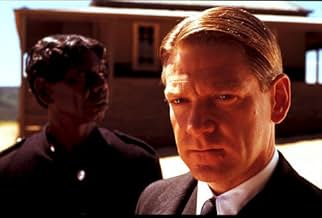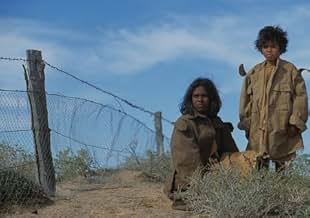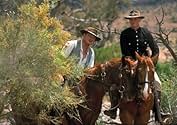En 1931, tres niñas mitad blancas y mitad aborígenes huyen después de que se las lleven de sus casas para entrenarlas como empleadas domésticas y emprenden un viaje por el interior de Austra... Leer todoEn 1931, tres niñas mitad blancas y mitad aborígenes huyen después de que se las lleven de sus casas para entrenarlas como empleadas domésticas y emprenden un viaje por el interior de Australia.En 1931, tres niñas mitad blancas y mitad aborígenes huyen después de que se las lleven de sus casas para entrenarlas como empleadas domésticas y emprenden un viaje por el interior de Australia.
- Dirección
- Guionistas
- Elenco
- Premios
- 23 premios ganados y 25 nominaciones en total
- Miss Thomas
- (as Lorna Leslie)
- Dirección
- Guionistas
- Todo el elenco y el equipo
- Producción, taquilla y más en IMDbPro
Opiniones destacadas
For those who do not know the desert regions of Australia, it must be said that the "outback" country is harsh and cruel and can only be crossed by those with experience...those with a knowledge of the land. I think the camera makes it clear that the hostile environment is very much like a fence in itself...almost impossible to cross. All the more remarkable therefore that these girls accomplished what they set out to do. May be it was a reckless decision they made but thanks to the fence they found their way back to family and friends.
The film is largely a record of the long trek and the manner in which the children are able to survive. There are not many dramatic moments on their journey south. The children are mainly concerned with avoiding the blacktracker who is following them. The most unforgettable scene comes early in the film when the children are forcibly torn from their mothers. This is truly heart-wrenching stuff.
This thoughtful presentation is worth watching. It is part of Australian history.
As for all journeys, they are filled with internal conflict and confrontations with strangers. These confrontations with certain people show the diverse group of settlers in Australia. Not all were ignorant but most were repressed and abided to the harsh cultured laws. For instance, the girls arrive at a farmstead and are given clothing and food by a white woman. The motherly instinct of this woman understood that the girls had to be with their mothers. But at the same token the farm woman could not jeopardise her own family by looking after the girls or else it would have brought trouble. It was wonderful scenes like these that was played out visually without having to dumb it down with words. As human beings we understand these actions and need no explaining.
The most interesting relationship was the one between the aboriginal tracker in search of the girls. He could sense the persistence of these girls to get home by making it difficult for him to track them down. This he respected and slightly dropped his guard. Once again, a string of images tell of this distant relationship between tracker and girls.
The images also became so strong during the scene when the girls were taken from their mothers in a horrific manner. I doubt there will be a dry eye during that scene. This hooks you in as you then become the spirit of their journey back home.
Only by the performances of the girls do these scenes work because they are so natural and heartfelt. Children who overplay their role just become cute but those who underplay and rely on emotions of the situation deliver a powerhouse performance that a trained actor may sometimes find difficult to achieve. At first the name of a high calibre actor - such as Kenneth Branagh - in an Australian film warns you where the limelight will shine. But Kenneth just took a step back and become another important confrontational figure in the journey.
A bonus is the music by Peter Gabriel. It is a mixture of his famous trademark of world music infused with that of the Aboriginal. It soars and plays with the emotions, maybe a little too much but when you are dealing with a thousand year old culture that has music as its central universe, then you may be able to understand that the overpowerful music is just an extension of that.
Congratulations to all who were brave enough to bring a project of this strength to the screen. And for those who may wonder how I saw the film prior to its release, lets just say I was lucky enough to be at the right place at the right time. And No! I'm not tied to the project in any way because I don't sell out that easily.
The three young girls, Mollie, Grace and Daisy, are stunningly portrayed by Everlyn Sampi, Tianna Sainsbury and Laura Monaghan. Molly, at 14 the oldest, has the largest part but the three of them function together as if they really were sisters. Their mother and grandmother , played by Ningali Lawson and Myana Lawson (daughter and mother in real life) are equally convincing, as is David Gulpilil as the relentless black tracker.
The most difficult role in the film is that of A O Neville (Mr Devil, as the aborigines called him), Chief Protector of Aborigines, a sincere and energetic advocate of the monstrous policy which resulted in a generation or more of half-cast children being removed from their families. It would be easy to pillory Neville as a monster, but Kenneth Branagh manages to give us a rounded picture of a man who was not inhumane, who tried to advance what he saw as the welfare of his charges despite lack of money and enormous logistical problems (not to mention an unco-operative police force). Had it not been for these obstacles the aboriginality of Australia would probably have been reduced to a few scattered reserves in the deserts run as freak shows for tourists.
Some critics of the armchair lefty variety have criticised the movie as not being political enough, and its true there's plenty of room for righteous (or leftist) indignation on the topic of the stolen generation, but I think a more overt political message would have diminished it. Imagine say, if John Pilger had made this film. Instead we have a near-classic. Never I have I seen the visual power of the Australian landscape better depicted, and seldom have I seen a better celebration of the human spirit. And this is a true story. The real Molly and Daisy take their bows at the end. Things didn't quite work out for them the way they might have, but they survived and stayed with their people.
¿Sabías que…?
- TriviaEverlyn Sampi (Molly Craig) ran away twice during filming. In one instance, she was found in a phone booth, trying to buy tickets back to Broome.
- ErroresThe three girls Molly, Gracie and Daisy were not taken by surprise and removed by force from Jigalong. The violent removal scene in the film is entirely fictional. The girls' mothers were informed beforehand they were to travel with Constable Riggs and, without any protest, they acquiesced in the decision. The girls left Jigalong on horseback, not locked in a motor car.
- Citas
Daisy Kadibill: [after Molly lifts Daisy up to a bird's nest to gather some eggs to eat] Three of them!
Molly Craig: Perfect. One for you, one for me, and one for both of us!
- Créditos curiososThe painting songs sung by the Walpiri, Amatjere and Wangajunka women were not sacred songs, but were songs able to be performed in public.
- ConexionesEdited from A Steam Train Passes (1974)
- Bandas sonorasNgankarrparni
(Sky Blue Reprise) (2002)
Written by Peter Gabriel
Featured by The Blind Boys of Alabama, Myarn Lawford (as Myarn) and Ningali Lawford
Selecciones populares
- How long is Rabbit-Proof Fence?Con tecnología de Alexa
Detalles
- Fecha de lanzamiento
- País de origen
- Sitio oficial
- Idiomas
- También se conoce como
- Rabbit-Proof Fence
- Locaciones de filmación
- Productoras
- Ver más créditos de la compañía en IMDbPro
Taquilla
- Presupuesto
- USD 6,000,000 (estimado)
- Total en EE. UU. y Canadá
- USD 6,199,600
- Fin de semana de estreno en EE. UU. y Canadá
- USD 88,352
- 1 dic 2002
- Total a nivel mundial
- USD 16,220,968
- Tiempo de ejecución1 hora 34 minutos
- Color
- Mezcla de sonido
- Relación de aspecto
- 2.35 : 1
Contribuir a esta página
































